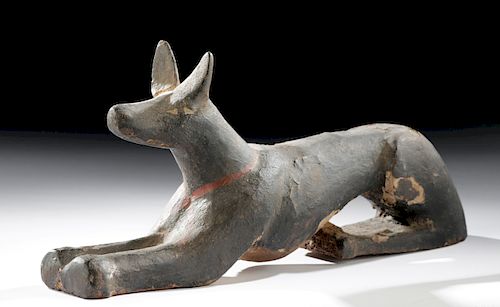Egyptian Wood & Painted Gesso Recumbent Jackal - Anubis
Lot 10a
About Seller
Artemis Fine Arts
686 S Taylor Ave, Ste 106
Louisville, CO 80027
United States
Selling antiquities, ancient and ethnographic art online since 1993, Artemis Gallery specializes in Classical Antiquities (Egyptian, Greek, Roman, Near Eastern), Asian, Pre-Columbian, African / Tribal / Oceanographic art. Our extensive inventory includes pottery, stone, metal, wood, glass and textil...Read more
Estimate:
$2,500 - $4,000
Absentee vs Live bid
Two ways to bid:
- Leave a max absentee bid and the platform will bid on your behalf up to your maximum bid during the live auction.
- Bid live during the auction and your bids will be submitted real-time to the auctioneer.
Bid Increments
| Price | Bid Increment |
|---|---|
| $0 | $25 |
| $300 | $50 |
| $1,000 | $100 |
| $2,000 | $250 |
| $5,000 | $500 |
| $10,000 | $1,000 |
| $20,000 | $2,500 |
| $50,000 | $5,000 |
| $100,000 | $10,000 |
| $200,000 | $20,000 |
About Auction
By Artemis Fine Arts
Sep 26, 2019
Set Reminder
2019-09-26 10:00:00
2019-09-26 10:00:00
America/New_York
Bidsquare
Bidsquare : Exceptional Day 1: Antiquities & Asian Art
https://www.bidsquare.com/auctions/artemis-gallery/exceptional-day-1-antiquities-asian-art-4437
Day 1 of an important 2-day auction featuring exceptional, museum-worthy examples of Egyptian, Greek, Etruscan, Roman, Viking, Russian, Near Eastern, as well as Asian Art from China, Japan, Thailand, Vietnam, Burma and India. Artemis Fine Arts info@artemisgallery.com
Day 1 of an important 2-day auction featuring exceptional, museum-worthy examples of Egyptian, Greek, Etruscan, Roman, Viking, Russian, Near Eastern, as well as Asian Art from China, Japan, Thailand, Vietnam, Burma and India. Artemis Fine Arts info@artemisgallery.com
- Lot Description
Egypt, Late Dynastic to Ptolemaic period, ca. 664 to 30 BCE. A charming couchant wooden Anubis depicted in his natural jackal form. The sculpture sits in a perky but pensive position with raised ears, hind legs tucked beneath his slender body, and forelegs extended in front. Extensive remains of gesso and jet-black pigment are visible along each part of the body, with faint traces of red pigment forming a collar around the neck. The tapered head features a conical snout with an incised mouth as well as a pair of almond-shaped, white-painted eyes. Artists in ancient Egyptian times depicted examples of Anubis as a recumbent canine to show guardianship or attentiveness in homes, sacred sites, and tombs. An exceptional zoomorphic likeness to the revered god of the embalming process and the dead. Size: 11.9" L x 2.6" W x 5.25" H (30.2 cm x 6.6 cm x 13.3 cm).
Wooden representations of sacred animals and deities were often placed into Egyptian tombs belonging to high-status individuals. Similar figures were also made to grace furniture and other everyday objects which were sometimes placed into the grave as well. Anubis, based on the real animal called the African golden jackal, is a god associated with mummification and the afterlife and is usually depicted as either a canine or a man with a canine head. Like many Egyptian deities, the role of Anubis changed over time. During the First Dynasty, he was a protector of graves and an embalmer. In the Middle Kingdom period, Osiris claimed Anubis' role as lord of the underworld, but Anubis continued to weigh the hearts of the dead against a feather to determine if they were deserving of eternal life.
Anubis is also associated with Wepwawet (Upuaut), an Egyptian god based on the African golden wolf, with grey or white fur in contrast to that of Anubis. Together, they were worshipped at the city of Asyut which was called "Lycopolis" (city of wolves) by the Greeks. In 1895, American traveler William Vaughn Tupper described Asyut: "In the hills seen on the horizon are the tombs of the priests and numberless holes in the rocks once filled with mummies of the Jackal...the hills are now strewn with skulls and bones of the Jackals" (from the William Vaughn Tupper Scrapbook Collection, Boston Public Library).
For a stylistically-similar example with less remaining pigmentation, please see The British Museum, museum number EA61506.
Provenance: private J.H. collection, Beaverton, Oregon, USA; ex-private New York, New York, USA collection; ex-private Connecticut, USA collection; ex-John N. Winnie, Jr. collection, Georgia, USA, acquired in the 1980s to 1990s
All items legal to buy/sell under U.S. Statute covering cultural patrimony Code 2600, CHAPTER 14, and are guaranteed to be as described or your money back.
A Certificate of Authenticity will accompany all winning bids.
We ship worldwide and handle all shipping in-house for your convenience.
#149646Original tail missing. Repair to right ear and left ear restored, with light resurfacing and overpainting along new material and break lines as shown. Minor abrasions and chips to limbs, head, and original gesso, with fading to original pigment, and light encrustations. Nice earthen deposits and great traces of original pigment throughout.Condition
- Shipping Info
-
All shipping is handled in-house for your convenience. Your invoice from Artemis Gallery will include shipping calculation instructions. If in doubt, please inquire BEFORE bidding for estimated shipping costs for individual items.
-
- Buyer's Premium



 EUR
EUR CAD
CAD AUD
AUD GBP
GBP MXN
MXN HKD
HKD CNY
CNY MYR
MYR SEK
SEK SGD
SGD CHF
CHF THB
THB















